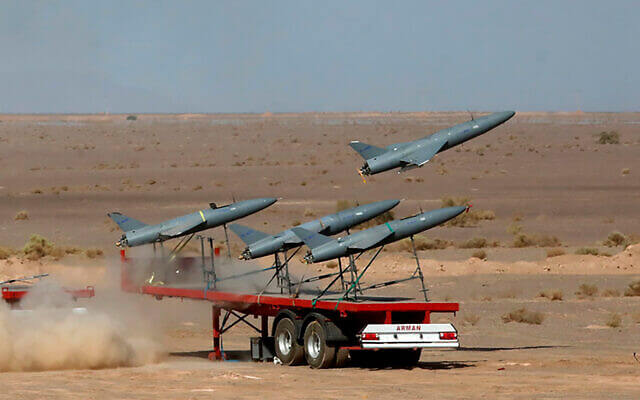Russia has reached an agreement with Iran to manufacture hundreds of drones on Russian soil, the Washington Post reported on Saturday. Officials familiar with the matter told the newspaper that the United States and Western intelligence agencies believe Moscow and Tehran are “moving rapidly to transfer designs and key components that could allow production to begin within months.”
Saying the two countries finalised the deal in early November, officials noted the agreement signalled “a further deepening” of their alliance, as it would give the Russian military a long-term supply of precision-guided missiles. With Iranian help, Russia could “dramatically increase” its dwindling military arsenal and prolong the war, probably even giving the Russian military an upper hand over Ukrainian forces, the report notes.
The officials called the agreement an “aggressive effort” by Moscow and Tehran to promote the manufacture of Iranian-designed drones in Russia. They remarked that Iran was keen to sign the deal since it believes it can avoid new sanctions if the drones are assembled and manufactured in Russia.
Russia sent top defence officials as part of several delegations to Tehran to negotiate the agreement, including a team led by Security Council Secretary Nikolai Patrushev.
Iran’s regime is practiced at exporting indigenous drone production capabilities to its regional proxies. Now this is coming to Russia. This is what a world looks like without a UN arms embargo on Iran and missile restrictions which expire in less than a year.
— Jason Brodsky (@JasonMBrodsky) November 19, 2022
US National Security Council spokesperson Adrienne Watson told the Post, “Tehran is helping [Russia] kill Ukrainian civilians through the provision of weapons and assisting Russia in its operations.”
“The US—with allies and partners—is pursuing all means to expose, deter, and confront Iran’s provision of these munitions and Russia’s use of them against the Ukrainian people,” she added.
While Russia declined to comment on the issue, a spokesperson for Iran’s permanent mission to the United Nations told the Post that Iran and Russia have “maintained bilateral defence, scientific, and research cooperation, that predates the start of the Ukrainian conflict.”
He rejected allegations that Iran has been supplying weapons to Russia. “Significant steps have been taken so far in the collaborative dialogue between Iranian and Ukrainian defence experts, and it will continue to clear up any misunderstanding on this matter,” the spokesperson noted.
According to the Post, Iran has supplied over 400 drones to Russia, including the Shahed and Mojaher versions, which the Russian military has used to devastating effect in several Ukrainian cities.
Ukraine has also accused Iran of supplying drones to replenish Russia’s depleting arsenal and help it prolong the war. Kyiv has called for more military support and asked Western countries to impose further sanctions on Tehran.
5/ Another factor to consider is the reaction of the Russian defense industry that manufactures military UAVs to this Iranian acquisition. In the past, the reaction to procuring drones from Israel back in 2011 was muted. I wonder if there will be open discontent this time.
— Samuel Bendett (@SamBendett) November 19, 2022
It has also accused Iran of violating a 2015 UNSC resolution—backed by the United Kingdom, the US, and France—that banned Iran from supplying drones capable of flying 300 kilometres (km).
In September, Ukraine downgraded diplomatic ties with Iran over its decision to support Russia militarily. Ukrainian President Volodymyr Zelensky noted that Russian forces had used Iranian drones to attack the Dnipro and Odesa regions and claimed that Ukrainian troops had shot down nine Iranian drones.
The US, too, has said that Iran is supplying drones to Russia and alleged that it has even sent Iranian officials to Crimea to provide technical support on how to use the drones.
Western intelligence agencies have claimed that Tehran also plans to sell ballistic and anti-aircraft missiles to Moscow. In fact, the Post reported last week that Iran is preparing to send surface-to-surface and ballistic missiles, including the Fateh-110 and Zolfaghar missiles, which have a range of 300 km and 700 km, respectively.
Moreover, according to another report, Russian military aircraft transported $140 million in cash and an assortment of Western weapons—a British NLAW anti-tank missile, an American Javelin anti-tank missile, and a Stinger anti-craft missile—captured in Ukraine to Iran in exchange for Iranian drones.
Meanwhile, since the start of the war in February, Russia has seen significant losses in military equipment, including the destruction of over 2,800 tanks, more than 5,800 armoured vehicles, 1,800 artillery systems, 390 Multiple Launch Rocket Systems, 200 anti-aircraft warfare systems, 270 aircraft, 260 helicopters, 1,500 drones, 480 cruise missiles, 16 warships, and 4,300 vehicles and fuel tanks, according to Ukraine. Furthermore, Kyiv has dealt a lot of damage to Russian weaponry through drones, especially the Turkish-manufactured Bayraktar TB2.
These losses have pushed Russia to turn not only to Iran but also to North Korea, from whom it has reportedly begun acquiring artillery shells.

